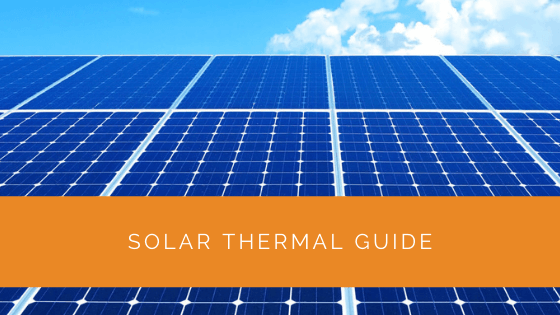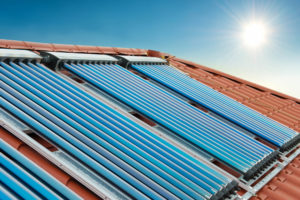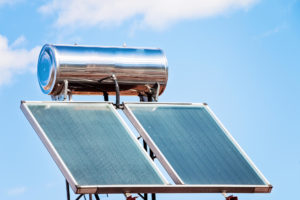Are you tired of constantly rising energy bills? Do you want to make a positive impact on the environment? If so, solar thermal panels may be the solution you’ve been searching for. Unlike traditional solar panels, solar thermal panels use sunlight to generate heat, making them an ideal option for homes and businesses looking to reduce their carbon footprint, save money on energy bills, and move towards a more sustainable future.
In this comprehensive guide, we’ll take a deep dive into the world of solar thermal technology. We’ll explore the various types of solar thermal systems available, the components needed for installation, and the benefits and drawbacks of adopting this renewable energy solution. By the end of this article, you’ll have a clear understanding of how solar thermal technology works and whether it’s the right choice for your energy needs.
Contents
- 1 Key Takeaways
- 2 What are Solar Thermal Panels?
- 3 What are the Different Types of Solar Thermal Systems?
- 4 How Do Solar Thermal Panel Systems Work?
- 5 What are the Components Found in a Solar Water Heating System?
- 6 How to Install a Solar Thermal System?
- 7 What are the Benefits of a Solar Thermal System?
- 8 What are the Disadvantages of a Solar Thermal System?
- 9 How to Choose the Right Type of Heating System?
- 10 Things to Keep in Mind Before Installing a Thermal System
- 11 Case Study: Solar Thermal System Installation for a Residential Property
- 12 Expert Insights From Our Solar Panel Installers About Solar Thermal Systems
- 13 Discover the Power of Solar with Solar Panels Network
- 14 Wrapping Up
Key Takeaways
- Solar thermal panels also referred to as solar water heating collectors, are widely utilised and can result in significant annual savings on hot water and energy expenses for households.
- There are two main types of solar thermal systems for heating water: flat plate collectors and evacuated tube collectors, each with advantages and limitations.
- Solar thermal systems offer benefits like reduced energy bills, year-round power supply, and environmental friendliness, but they are weather-dependent and have installation costs and limitations.
What are Solar Thermal Panels?
A solar thermal panel is not the same as a solar panel. While solar panels utilise the heat from the sun to generate electricity, the process is different in solar thermal technology. Here, sunlight is used to generate heat instead of electricity.
Usually, the heat energy produced by solar thermal panels is used for water heating purposes. In short, this is how solar thermal technologies operate: the solar panels installed on households’ rooftops function as sunlight collectors. The heat energy thus generated is then used to heat the water. Finally, the heated water is transported for daily use via connected tubes.
Solar thermal collectors are generally used for water heating but have other applications; for instance, these collectors function as solar parabolic troughs, towers, and air heaters.
However, in the UK, solar thermal collectors are predominantly used in residential buildings and large households with significant domestic hot water needs.
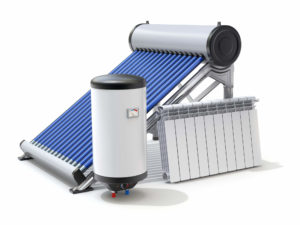
What are the Different Types of Solar Thermal Systems?
There are two solar thermal system types dedicated to heating water, and they are as follows:
Flat Plate Collectors
A flat plate collector is usually comprised of four main parts-
- An enclosure
- An absorber plate of dark shades
- A transparent cover
- Insulation on the front and back surfaces of the solar collector
The absorber plate’s function is to establish fluid circulation passageways. The absorbers can be made of polymers, copper, aluminium or steel. On the other hand, the purpose of the transparent cover is to facilitate optimum penetration of solar energy. Most flat plate collectors use a honeycomb structure to reduce the loss of heat energy.
In flat plate collectors, water is the ‘working fluid’. This type of thermal system works well in temperatures lower than 100 degrees Celsius. The average lifespan of a flat plate collector is pegged at 25 years.
Evacuated Tube Collectors
While evacuated tube collectors, also known as ETCs, are not very common in the UK, they are widely used in other parts of the globe.
An ETC is comprised of the following parts:
Glass evacuated tubes
- A heat pipe
- A condenser
- A collection tube
- Heat transfer fluid
- Insulation and aluminium casing
In ETCs, rows of evacuated glass tubes are arranged in parallel rows. Moreover, each inner glass tube usually comes with a heat pipe attached to it. By removing the air between two pipes, a vacuum is created. This vacuum is very effective in preventing heat loss. Due to their heat energy transfer efficiency, ETCs can function well in temperatures well above 200 degrees Celsius.
Depending on the life span of the vacuum, an evacuated tube collector’s lifespan can last anywhere between 5 to 15 years.
Evacuated tube collectors are particularly effective in colder climates, as the vacuum insulation minimises heat loss, making them more efficient during the winter months.
The commonly used solar collectors are through-pass air collectors and unglazed transpired solar collectors for air heating.
How Do Solar Thermal Panel Systems Work?
The working principle remains the same regardless of whether it’s a flat plate collector or an ETC. See for yourself:
- Depending on the purpose, the solar panels will be connected to a heater, collector or boiler
- The solar collector will utilise the sunlight to heat transfer fluid. Coated with an anti-freeze substance, the collector will prevent the liquid from getting cold.
- Once the water is heated, it gets transferred from the collector to a heat exchanger.
- The heat exchanger then heats the water once again
- The heated water gets delivered to households
- If there is any unused water, it will be circulated back to the collectors for reheating.
- The process is then repeated cyclically
What are the Components Found in a Solar Water Heating System?
A solar water heating system’s structure differs slightly from the flat plate or tube collector. Here are the components that play a significant role in the overall functioning of a solar water heating system:
- Solar Thermal Panels: Usually, these panels are fixed on the roof or the ground
- Heat Transfer Fluid: Like the two types of collectors, even a solar water heating system uses a heat transfer fluid
- Heat Exchanger Coil: The dual coil plays a significant role, as it allows the heating system to provide extra hot water when required
- Pump: The pump’s function is to circulate the transfer fluid from the panels to the cylinder
- Piping: The flow piping and the return piping are involved in maintaining insulation between the panels.
- Control Panel: Displays all the information related to the water heating system’s performance
- Heat Flow Generation Meter: This measures the overall output of the system.

How to Install a Solar Thermal System?
The installation of solar thermal systems involves elaborate steps and procedures:
Before Installation
- In the UK, it is recommended that all households, before the installation, need to get their property inspected by personnel with MCS accreditation.
- Ideally, your property will be inspected for the roof’s orientation, inclination and other related factors.
- Depending on their findings, the surveyors will give you an estimate of the output of energy you can expect after installing solar thermal systems.
- Likewise, the surveyor will also try to determine the domestic water needs of your household.
Solar Thermal Collector
- The collector frames will be installed on the flat roof using stainless steel brackets.
- The brackets will be fixed directly to the roof to create a tight structure.
- Your roof tiles might have to be removed but will be replaced once the solar thermal installation is complete.
- If you have opted for an ETS, a transfer unit will be juxtaposed atop the frames.
Hot Water Cylinder
- A dual coil water cylinder will be installed first, followed by a pump and system control panel.
- The installers will then install a hot water tank, which is required for solar energy storage purposes.
- The tank will be connected to various equipment like cold water mains, auxiliary heating, immersion heater, temperature sensors and an expansion vessel.
Solar Thermal System Plumbing
- The installers will first place a pumping station to fix the pump.
- An expansion tank will be fitted in to monitor pressure changes as a preventive measure.
- Insulated pipes will go in next, creating the flow and returning the piping channel for fluid transfer.
- The installers will ensure enough distance between all the plumbing components.
Controls and Display System
- Finally, the solar thermal system’s display components will be setup
- The installer will begin by fitting a heat generation meter
- Automatic control equipment will also be installed
Pumping of Transfer Liquid
- The installer will pump the transfer and anti-freeze liquid into the fully assembled solar thermal heating system as a final step.
The liquid will be subjected to pressure, according to specifications
It is essential to ensure that the installation meets local building regulations and safety standards. Always work with certified professionals to avoid any compliance issues.
Sometimes, you might need planning permission before installing solar heating systems.
Planning Permission and When It’s Needed
In most cases, domestic and residential solar water heating systems can be installed without planning permission. However, permission will be required in the following cases:
- If the panels are installed on the walls of a building containing flats
- If the panels protrude from the edges of a flat roof
- If the panels project upwards, i.e. if their height exceeds the limit
- If the house or building is situated at a World Heritage Site
- Solar panels should be installed without compromising the aesthetics of the building

What are the Benefits of a Solar Thermal System?
There are many benefits of installing a solar thermal system, and they include:
- Less space: To install solar heating systems, you require less space, making it a convenient option for many households
- Simple: The technology and processes involved are straightforward. As a result, the system is easy to understand and operate.
- Limitless Energy: Since solar energy is renewable and available in abundance, there’s no limit to the amount of energy that a solar thermal system can generate
- Seamless Integration: Solar thermal systems can be easily paired with existing power sources
- Increased Savings: It is a lot cheaper to heat water using a solar water heating system, leading to considerable savings in the electricity bills
- Year-round Power Supply: With advancements in solar technologies, most solar thermal systems can work efficiently during the winter months as well, powering households and commercial establishments throughout the year
- Environment Friendly: Using a renewable energy source for heating water and power generation means no fuss about using fossil fuels.
- Reduced Carbon Footprint: There are no CO2 emissions with solar heating technologies. Besides, a solar hot water cylinder significantly reduces the carbon footprint. It is estimated that, on average, a UK household can reduce its carbon emissions by over 400 kg each year.
What are the Disadvantages of a Solar Thermal System?
Nonetheless, there are a couple of disadvantages of solar thermal systems that you need to consider:
- Weather-dependent: Poor local weather conditions can hamper the hot water supply in households. During winter, the solar water heating cylinder’s efficiency will be reduced.
- Singular Function: If you opt for thermal systems meant exclusively for water heating, that’s the only function it can perform. This singularity can be a dampener for many.
- Costs: It can take up to 20 years or so to see visible returns on investment.
- Expensive and Long-drawn Installation: The installation process takes time, and the cost is also high
- Limited Availability of Installers: It’s hard to find installers for water heating systems that are solar-powered in the UK
- Limited Storage Capacity: While all solar water heating systems do come with storage facilities, the hot water cannot be stored for long
Solar thermal systems may also require regular maintenance to ensure optimal performance, including periodic checks and potential repairs.
Solar PV Panels vs Thermal Heating Systems
Many struggle to understand the difference between solar PV panels and thermal heating systems. However, the differences are distinct and cannot be ignored:
- Technology: Solar PV panels’ working principle is driven by the photovoltaic effect, while in a solar water heating cylinder, sunlight is used directly to heat the water
- Complexity: In solar panels, the energy conversion process is rather complicated when compared with the procedures in a solar immersion heater or other thermal energy appliances
- Use: While households use solar PV panels mainly for electricity generation, solar heating systems are used for domestic and industrial hot water supply and storage.
- Design: In terms of design and building solar PV panels have a more straightforward structure and assembly procedure than solar heating systems
- Lifespan: Domestic solar PV systems last longer than their thermal counterparts
Solar Thermal Systems and Energy Bills: The Equation
How much could a household in the UK save by installing a solar system? Here is what to expect.
To begin with, the savings will be directly influenced by daily hot water usage. Further, your savings will also depend, to a considerable extent, on the existing energy system you have installed.
However, it is estimated that a solar thermal system installation can save a household around £50 in a gas system, £55 in an oil system, £65 in a coal system, and £95 in an LPG system per year. Now, that’s a lot of savings in a year.
Additionally, households may benefit from government incentives or rebates, further enhancing the financial attractiveness of solar thermal systems.
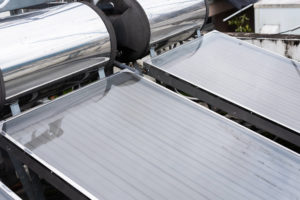
How to Choose the Right Type of Heating System?
While solar heating systems can be classified depending on the collector type, another classification is also possible. Here, the systems are classified according to how they use the collectors. They are as follows:
- Active: In this type, you’ll need electricity to power the pumps
- Passive: Passive systems usually make use of natural heating methods, like convection, to get the job done
- Direct: The water is heated directly in the collector
- Indirect: A two-step process is involved here. First, the transfer liquid is heated in the collector, and then the heat is automatically transferred to the water.
- While choosing a heating system for your household, keep in mind the two classifications: the collector type and how it’s being used.
Things to Keep in Mind Before Installing a Thermal System
If you plan to install a thermal system, it will help if you ensure the availability of three things: a spot that receives plenty of sunshine, sufficient space, and a boiler. A sunshine spot is essential, as thermal power generation relies heavily on the availability of the sun’s energy.
Similarly, thermal systems require space for installation and maintenance. Moreover, the solar cylinder that’s a prerequisite will also take up some space.
At times, the existing boiler at home might not be compatible with a thermal system. In this case, you will need to install a new one and the system.
Case Study: Solar Thermal System Installation for a Residential Property
Background
A family residing in a large home sought to reduce their energy expenses and environmental impact. With a significant demand for hot water throughout the year, they decided to explore solar thermal systems as a sustainable solution. Solar Panels Network was approached to design and install a system tailored to their needs.
Project Overview
The primary goal was to install a solar thermal system capable of meeting a substantial portion of the household’s hot water requirements. The chosen solution included a combination of flat plate collectors and evacuated tube collectors to ensure optimal performance across varying weather conditions.
Implementation
System Design and Installation
- Collector Installation:
- Flat Plate Collectors: Installed using stainless steel brackets on the south-facing roof section to maximise sun exposure.
- Evacuated Tube Collectors (ETCs): Positioned alongside flat plate collectors, these were selected for their efficiency in colder conditions.
- Hot Water Cylinder and Plumbing:
- Dual Coil Water Cylinder: Installed to store heated water, connected to temperature sensors, an immersion heater, and an expansion vessel.
- Plumbing Setup: Insulated piping was laid out to connect the collectors to the water cylinder, ensuring minimal heat loss during transfer.
- Control Systems:
- Control Panel: Set up to monitor system performance and manage the heat exchange process.
- Heat Flow Generation Meter: Installed to measure the system’s output.
Results
- Energy Savings: The solar thermal system provided approximately 70% of the household’s hot water needs, leading to significant reductions in energy bills.
- Environmental Impact: The installation resulted in an annual reduction of approximately 1,200 kg of CO2 emissions.
- System Efficiency: The dual approach of using flat plate and evacuated tube collectors ensured a reliable supply of hot water throughout the year, including during colder months.
Summary
This case study highlights the successful implementation of a solar thermal system tailored to a residential property’s specific hot water needs. By using a combination of flat plate and evacuated tube collectors, Solar Panels Network provided a solution that significantly reduced energy costs and carbon footprint. The project underscores the potential of solar thermal technology as a viable and sustainable energy solution for homes.
Expert Insights From Our Solar Panel Installers About Solar Thermal Systems
Solar thermal systems are an excellent way to harness the sun’s energy for heating water. They are particularly beneficial for homes with high hot water demand, as they can significantly reduce energy bills.
Solar Installation Specialist
One of the key advantages of solar thermal panels is their efficiency, especially during colder months. Even in less sunny conditions, evacuated tube collectors, in particular, perform exceptionally well, ensuring a consistent supply of hot water.
Renewable Energy Consultant
When installing solar thermal systems, it’s crucial to consider the system’s orientation and the household’s hot water requirements. Properly installed systems can provide a significant return on investment over time.
Lead Installer
Discover the Power of Solar with Solar Panels Network
Are you navigating the world of solar installations? Look no further than Solar Panels Network, the UK’s trusted partner in harnessing the sun’s potential. Our dedication goes beyond just installations; we’re on a mission to transform how homeowners and businesses across the UK perceive and utilise energy. By choosing us, you’re reducing your carbon footprint and making a smart financial move that promises savings for years ahead. Contact us today and embark on your solar journey.
Wrapping Up
Solar thermal power generation systems bring a host of benefits to the table. With the UK government introducing schemes, many households and commercial establishments have switched to solar thermal heating systems. There are different solar thermal systems, depending on the collector type and how it is being used.
A unique working mechanism powers them. In keeping with the same, every solar water heating system has components that play a crucial role in daily functioning and operation. Installing a thermal system is often elaborate and involves plumbing and pumping thermal transfer liquid.
While there are downsides to solar systems, they still hold an edge over solar PV panels. You can save a lot on your energy bills by choosing the right system for your household. To read more about solar thermal systems, please reach out to us.
About the Author
Solar Panels Network stands at the forefront of solar energy solutions, driven by a team of seasoned solar engineers and energy consultants. With over decades of experience in delivering high-quality solar installations and maintenance, we are committed to promoting sustainable energy through customer-centric, tailored solutions. Our articles reflect this commitment, crafted collaboratively by experts to provide accurate, up-to-date insights into solar technology, ensuring our readers are well-informed and empowered in their solar energy decisions.

